All Hail The King Of The Monsters
DIRECTED BY GARETH EDWARDS/2014
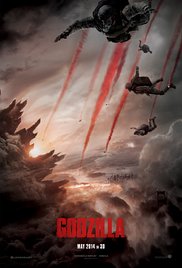 There are a few things I think you should know going in to the new Godzilla reboot.
There are a few things I think you should know going in to the new Godzilla reboot.
First of all, it’s really good. Technically, it might be the best Godzilla film since the 1954 Japanese original, Gojira. I say “might” because I can’t give an informed judgment, having not seen every single Godzilla movie ever made. But I have seen a fair few, and fairly few of those match up to this one.
Before you go see it, though, I think you’d be well served by getting to know the work of filmmaker Gareth Edwards, who was chosen to make this, his sophomore effort, on the strength of his debut, a micro-budgeted, independent sci-fi mumblecore movie called Monsters. Monsters is a very small, character-based drama from 2010 that takes place in the aftermath of a very large, earth-shattering event: the mass invasion of foreign alien species that hitchhiked down to Earth on the back of a crashed space probe. The movie is mostly about the relationship between two characters, and we don’t get our first good look at the titular monsters until the very end. It’s been on Netflix. Go watch it. I’ll wait.
Wasn’t that great? It’s also a pretty good indicator of what his newest film is like. Now, you certainly see a lot more monster action in Godzilla than in Monsters, but at the same time, Godzilla is still very much a Gareth Edwards movie. Just because he’s playing with a budget over 300x bigger than his last movie doesn’t mean he’s abandoning what made that movie work so well. Just like Monsters, Godzilla is a slow burn. This will undoubtedly throw people who are expecting something more like Guillermo Del Toro’s Pacific Rim. But this is a very, very different movie.
I’m not going to say it’s better or worse—just different. And honestly, I’m happy with that. I think there’s plenty of room in the Kaiju genre for multiple takes.
If Pacific Rim was more like the Batman (1966) of Kaiju films—fun and upbeat, filled with a childlike glee that hits the ground running; this new Godzilla is more like Batman Begins—slower and more methodical, it takes it time building to something amazing. Like that movie, it’s a while before we get our first really good look at Godzilla himself, but when we finally see him, boy-howdy is it worth it. And just like Edwards’ first film Monsters, Godzilla starts out as character-based drama, set out against the backdrop of a giant monster movie that’s happening in the background. This is a little frustrating at first, but it also allows us to get to know the people who are going to be running away from the giant monsters before those giant monsters actually show up.
Oh yeah—that’s the other thing. This isn’t a one-monster show. There are multiple Kaiju in this movie. The international trailer has revealed this, but it hasn’t really given you the context—and I’d argue that context would be enormously helpful in getting the maximum amount of enjoyment out of this movie.
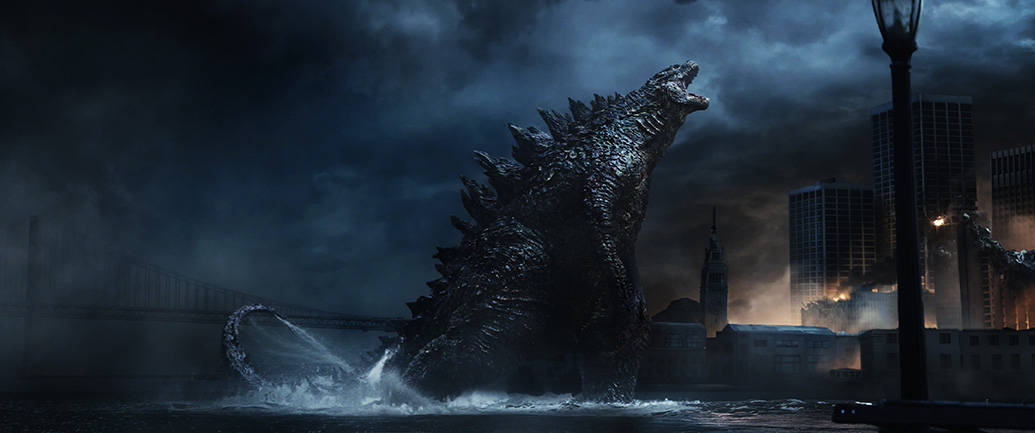
In order to get into the context of Godzilla, I’m going to need to discuss the basic plot of the film. Now, I in no way, shape or form consider this a spoiler discussion, but I also recognize that in the Internet age no one can seem to agree on what even constitutes a spoiler anymore. In my opinion, a spoiler is something that would actually spoil the initial enjoyment of a film by the average viewer. Here are some of the things I consider to be spoilers:
- Giving away answers to mysteries that the film hinges on.
- Giving away the fact that a movie might even have a twist, let alone the twist itself.
- Giving away anything in the movie that relies on surprise in order to work, such as special cameos or jokes. This includes the “money shots” or “hero moments” of the film, which are best enjoyed when the audience doesn’t know they’re coming.
- Giving away the ending.
Here are some of the things that I don’t consider to be spoilers:
- The basic framework of the film which is set up in the first act, or in the opening credits.
- Who the heroes and villains of a film are (barring surprise reveals, of course[1]).
That’s the stuff I want to talk about, and in order to review a movie well, I don’t really have any other choice but to talk about it. Yet, in deference to those who don’t want to know anything about the movie at all (in which case why are you even reading a review?), I give an eye-rolling “spoiler” warning for what I have to say next. Enjoy this GIF of Godzilla doing a happy dance, and then click on somewhere else. The rest of you, stay with me.
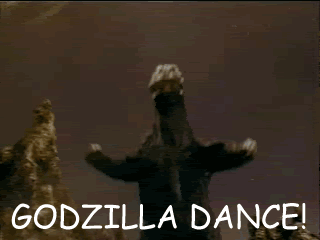
Still there? Okay. So, listen up: the marketing campaign for this movie has been a big fat lie.
All of it—the posters, the trailers, the TV spots, what-have-you, have sold Godzilla as an uber-dark disaster-type film starring Bryan Cranston as a very sad man vs. Big G himself, who is a relentless force of nature hell-bent on “send[ing] us back to the stone age,” and destroying all life on Earth, despite everything we can throw at him, including airplanes (which he knocks out of the sky) and halo-jumping paratroopers.
Yeah, um…no.
First of all, Bryan Cranston isn’t the star of this movie. He’s in it, and he has a very important part to play—especially in the beginning. But he’s by no means the central character. That would be Ford Brody (Aaron Taylor-Johnson, playing the son of Cranston’s Joe Brody[2]). The other lead is Dr. Ichiro Serizawa[3] (Ken Watanabe), who shoulders most of the heavy dramatic lifting—especially when Cranston isn’t onscreen (which is most of the movie). So why are the trailers making it look like Cranston is the star? My guess is that the marketing campaign is simply capitalizing on the fact that this is Cranston’s first big role since the end of Breaking Bad, one of the greatest television shows in history in which Cranston played Walter White, one of the best television characters in history. But despite what the trailers are telling you, he’s not the hero of this movie.
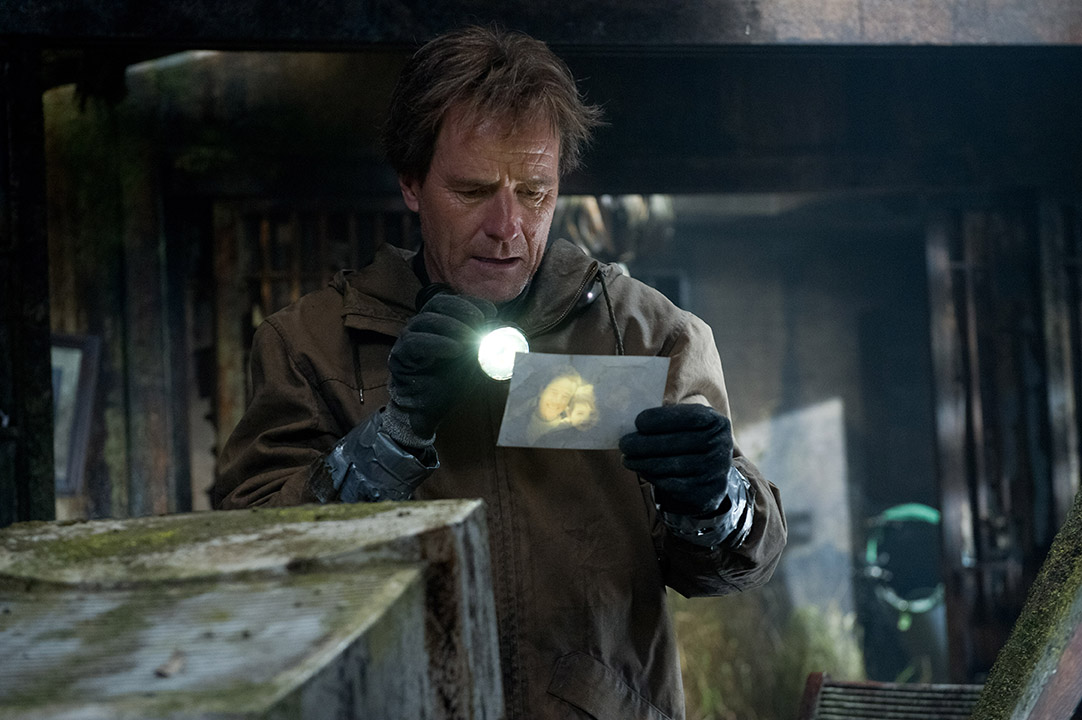
“Seriously? Are these ALL of my lines?”
That would be Godzilla himself.
Yep, this is a heroic Godzilla movie, just like in the Showa series of Godzilla films—specifically the ones that ran from 1964 (Ghidorah: The Three Headed Monster) to 1975 (Terror of Mechagodzilla), in which Godzilla protects the rest of us from much worse Kaiju than himself. The difference is that while those movies were pretty silly and aimed at children, Edwards’ new film is a more serious, PG-13, man-on-the-ground take on that version of Godzilla. Here, he’s more than a monster; more than a force of nature; more than a metaphor for the atom bomb. In Godzilla (2014), he’s much more akin to an ancient primordial god. Even though the filmmakers give lip service to the possibility of a scientific explanation for these monsters, at their core they’re really more mystical in nature. Essentially, they’re Great Old Ones. Godzilla’s like Cthulhu, only more on our side. This brings an added layer of existential awe to the character. We’re not talking an iguana that’s been mutated by radiation here—this is a being as old as time itself. For all intents and purposes, Godzilla’s a lot closer to the forest god from Princess Mononoke than he is to the malevolent Kaiju from last year’s Pacific Rim.
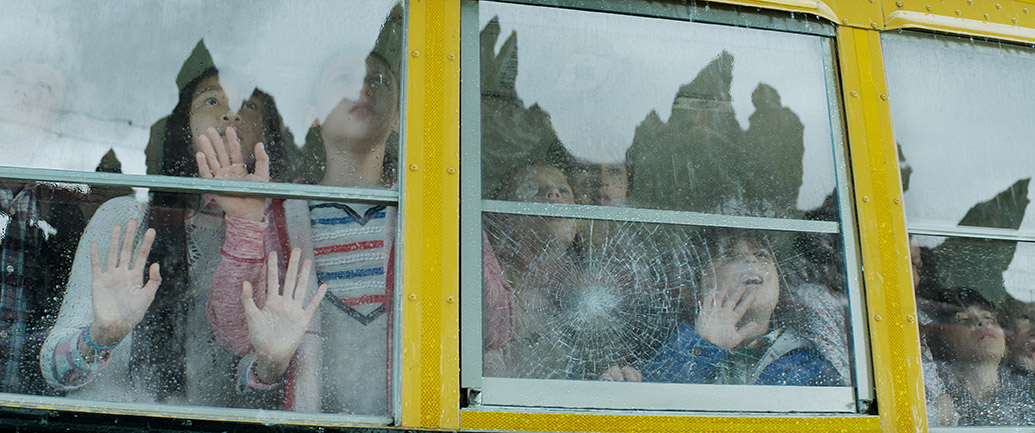
These kids know what’s up.
And honestly, this is the right way to go—especially if Legendary and Warner Bros. are going to continue with this series and introduce some of Godzilla’s other classic allies and enemies—especially King Ghidorah himself, Godzilla’s arch-nemesis. There’s no scientific explanation for a three-headed, lightning-breathed monster that isn’t going to sound ridiculously silly. But an ancient dragon god? Now that’s something I can get behind. To see this new, state-of-the-art King of the Monsters go toe-to-toe with Ghidorah in a mega-budgeted blockbuster? That’s something I only could have dreamed of before.
But Gareth Edwards has gone a long way towards making that dream a tangible reality. This gives him a Kaiju-sized edge over Roland Emmerich, the last Western filmmaker who attempted to reboot Godzilla for American audiences in 1998. That movie represented the worst excesses of American cinema—a mindless disaster movie; full of sound and fury, signifying nothing. But Edwards, an English director, has made a film that feels much more Japanese, and ultimately means a lot more: just as the original Gojira was very much a post-WW2 movie about the horror of the nuclear bomb we dropped on Hiroshima and Nagasaki, this Godzilla comments on the damage we’re doing in our time—albeit in a more subtle way.
Edwards’ film, without putting it into the dialogue, uses the visual language of climate change: the MUTO (Massive Unidentified Terrestrial Organism, the cause of all the actual destruction you see in the trailers [which are blaming it on Godzilla, who’s practically innocent in all this]) is first awakened by over-mining; when Godzilla first arrives on the scene in Hawaii to battle the MUTO, his emergence from the ocean causes a tidal wave not unlike the massive 2004 South Asian tsunami.
The earthquake that destroys the power plant in the first act is reminiscent of the disaster at the Fukushima power plant in 2011. The MUTO itself feeds on the radiation we produce—see, in this iteration, Kaiju (never named as such in the film) come from a primordial epoch millions of years before the dinosaurs, when the Earth was much hotter and much more radioactive. As the planet cooled, they moved underground, closer to the Earth’s core. The advent of nuclear power in the 40’s and 50’s woke them up and got their attention. As it turns out, all that nuclear testing at Bikini Atoll was actually us trying to kill Godzilla—the very entity who returns to save us over half a century later.
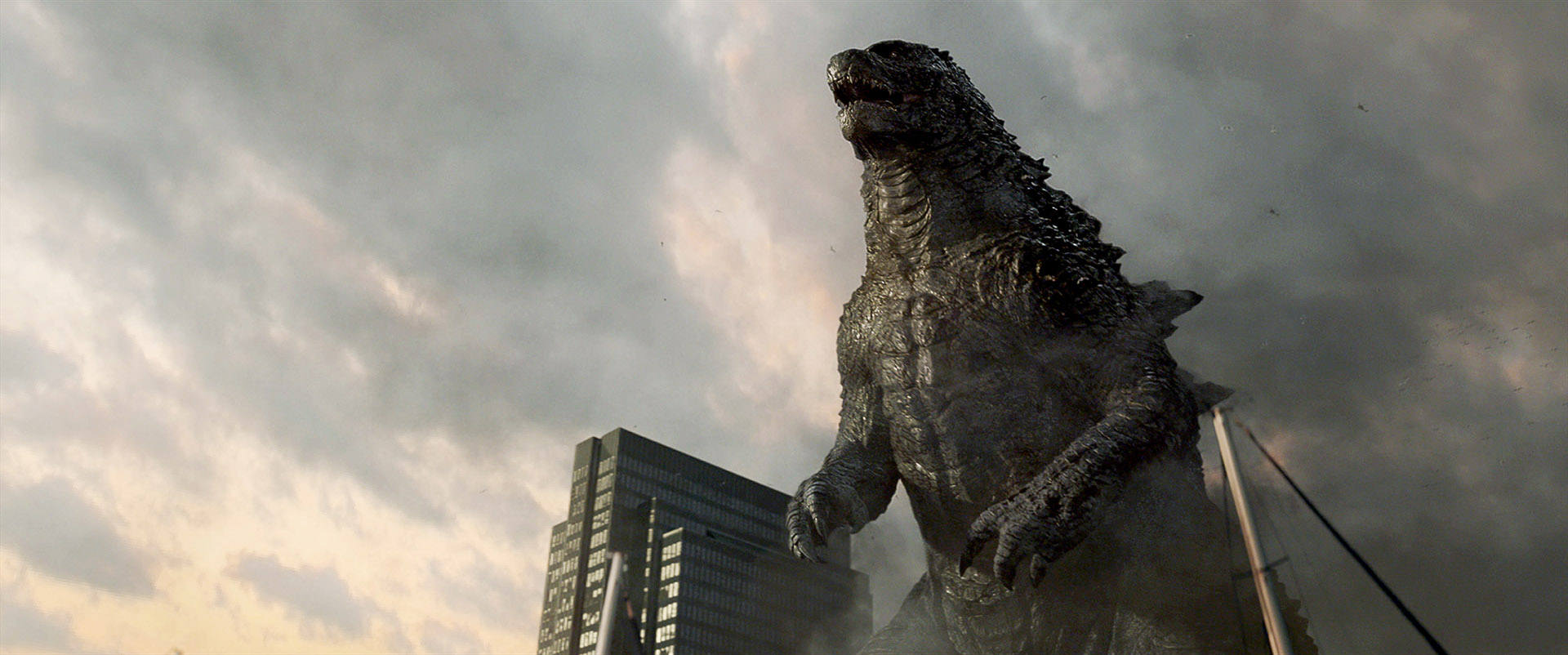
This is Godzilla at his most awe-inspiring. Like Bruce in Jaws, Edwards wisely parses out the full reveal of Big G until well into the film—and so when he finally shows up, after the MUTO has terrorized both Japan and Hawaii, it’s an incredible, wonder-inducing moment—the first of several—that earned audible applause from the audience.
Jaws isn’t the only Spielberg movie Edwards invokes[4]. There are subtle nods to Jurassic Park and Close Encounters as well. But Edwards isn’t simply ripping off the master, as JJ Abrams did with Super 8, without an understanding of what makes Spielberg’s style work so well in the first place. Edwards also demonstrates a knowledge of the kind of cause-and-effect visual storytelling that Spielberg has always excelled at. There’s a particular moment in the film that felt especially Spielbergian to me, and that serves as a good example of this understanding. It’s a moment that’s been previewed in some of the trailers.
When Godzilla first arrives in Hawaii, his emergence from the ocean generates a tidal wave. We first see a beach outside of a hotel at night, where tourists are relaxing, eating dinner, having cocktails, etc. The camera slowly pushes in on a barking dog tethered to a tree, as he reacts to something happening off-screen. We then see from his perspective that the water is sharply pulling back from the beach, signaling an approaching tsunami. A man notices the dog barking, and the sees what he sees, picking up his daughter. He tells everyone to run, and the crowd begins to flee. We see the water approaching, and the dog breaks his leash and runs away. The next shot follows the dog as he runs towards us, starting with a close up before pulling back to show the crowd of people escaping the oncoming wave.
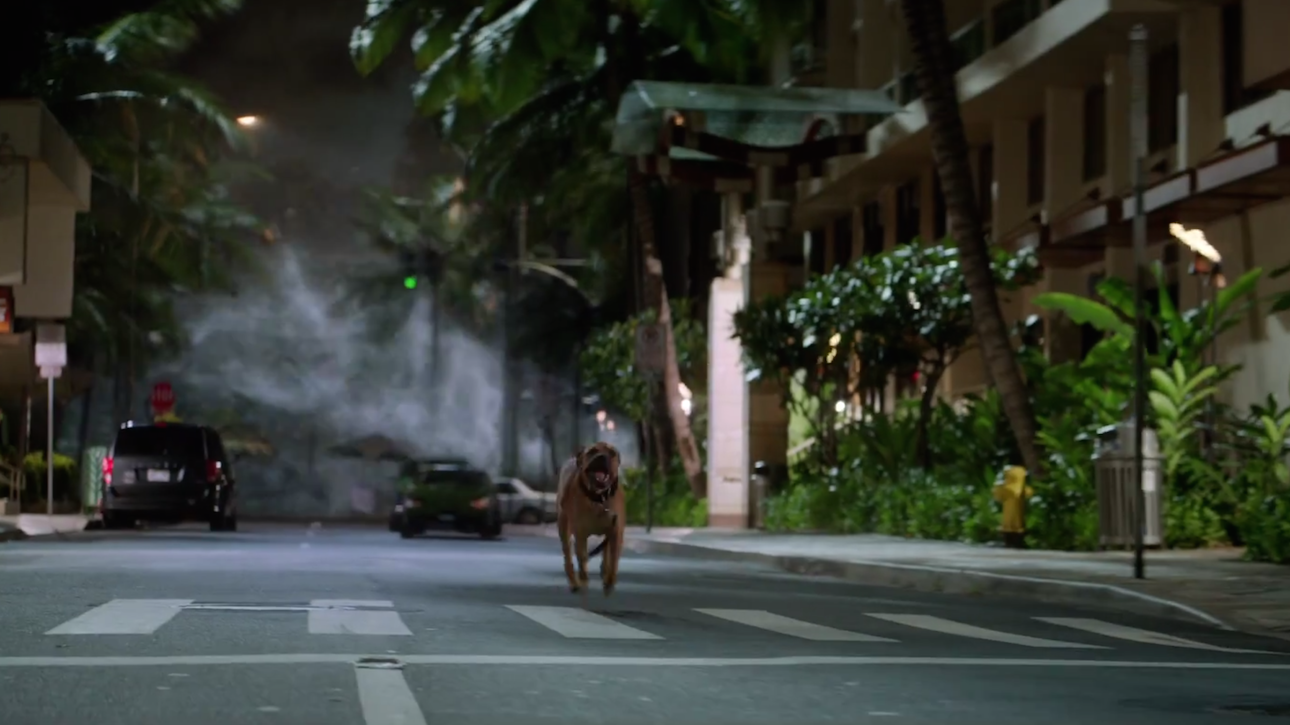
See Spot run from Godzilla. Run, Spot, run from Godzilla.
It’s a beautifully done sequence of visual storytelling that evokes Spielberg in the best way, and makes me excited to see what else Gareth Edwards has to offer.
He’s also quite adept at composing gorgeous shots. There are a number of beautifully realized aesthetic moments throughout this film, breathtaking in their beauty. The aerial halo jump that has been shown in the trailers is definitely a highlight, as are many of the moments between Godzilla and the MUTOs.
As for the MUTO’s themselves, they are also great characters in the film. Edwards has taken these bizarre, alien, giant insectoid creatures, and made them both terrifying and relatable at the same time. They’re definitely a threat that needs to be dealt with, but they’re not exactly evil, either—they’re creatures trying to survive, just like us—and there are a few notable moments in the film where they earn our sympathy. Though wisely, not enough to keep us from rooting for Godzilla to take them out.
When that battle finally comes, it’s well-worth the wait, and it’s actually more effective because Edwards has made us wait for it, rather than overload us and dull our senses with a relentless barrage of special effects that wears us down by the end of the film. This is a clear example of the artist knowing better than the audience, and giving us what we need rather than what we want, and I applaud Edwards for his discretion, his sense of pacing, economy of storytelling, and the way he slowly builds tension one piece at a time, leading to an enormous cathartic release at the end.
I just wish the marketing campaign gave audiences a better idea of what they could expect, that’s all.
[1] Reveals that are surprising to the actual characters in the movie, not inane audience-baiting like Benedict Cumberbatch’s dopey “My name is…Khan!” line from last year’s craptacular STD.
[2] This surname is no accident, and we’ll discuss that later on in the review.
[3] A name taken from the’54 Gojira (although his character is closer to that of Dr. Yamane from the same movie)
[4] And there are Jaws references a-plenty; from the surname of the main characters (Brody) to shots of Godzilla’s dorsal spines cutting through the ocean like a shark’s fin.

